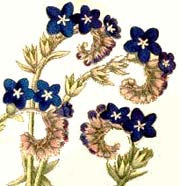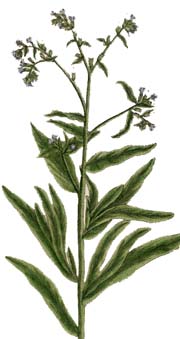|
 Anchusa officinalis Anchusa officinalis
Common Alkanet
This herb's beautiful blue
scented flowers appear in late summer; they are full
of nectar and attract bees.
As shown, the flowers appear in curling spikes
that resemble scorpions, and according to
Dioscorides, it helped heal the bites of venomous creatures
(which are Mars), so consider this herb for protection against magical attack. The dried leaves have a
musky fragrance and can substitute for animal musk in incense recipes. Cunningham
states that this herb can be burned as an incense against negativity.
In Herbalism
 According to Culpeper, common alkanet
is not only a Venus herb, but "one of her
darlings." He recommended it be made into an
ointment applied against various heats of the skin. Decocted into
wine, it was drunk to strengthen the back and relieve back pains. Extracted into
vinegar, it was even used against leprosy. Common alkanet is
a demulcent (soothing), typical for a Venus herb, although the leaves
are rough and scratchy. A cold infusion was a diuretic, and a hot one produced sweating. A homeopathic remedy for
ulcers is still made from this plant. The leaves and shoots can be cooked and eaten like spinach, and the flowers cooked or used as a garnish.
The tea was once a traditional remedy
for melancholy, but this plant contains some
alkaloids that are toxic to the liver, especially if it is used regularly (read
an article about it).
If you have a tender liver (if you have EVER been a heavy drinker, taken acetaminophen
regularly, or been exposed to a lot of solvents), don't ingest this
plant at all, and don't use it on a regular basis in any case. This
plant is worth growing for many other reasons than ingesting. According to Culpeper, common alkanet
is not only a Venus herb, but "one of her
darlings." He recommended it be made into an
ointment applied against various heats of the skin. Decocted into
wine, it was drunk to strengthen the back and relieve back pains. Extracted into
vinegar, it was even used against leprosy. Common alkanet is
a demulcent (soothing), typical for a Venus herb, although the leaves
are rough and scratchy. A cold infusion was a diuretic, and a hot one produced sweating. A homeopathic remedy for
ulcers is still made from this plant. The leaves and shoots can be cooked and eaten like spinach, and the flowers cooked or used as a garnish.
The tea was once a traditional remedy
for melancholy, but this plant contains some
alkaloids that are toxic to the liver, especially if it is used regularly (read
an article about it).
If you have a tender liver (if you have EVER been a heavy drinker, taken acetaminophen
regularly, or been exposed to a lot of solvents), don't ingest this
plant at all, and don't use it on a regular basis in any case. This
plant is worth growing for many other reasons than ingesting.
As a Dye
 The name alkanet comes from Arabic, al khenna
(henna), from the red color of the roots.The bark of the roots provides a weak
brownish red or lilac dye, which is not as strong as the dye of
its cousin, Anchusa tinctoria, dyer's alkanet, but common alkanet
does not need such a warm climate for growth as dyer's alkanet does,
so it has a long history of use as a dyeplant in northern Europe.
The roots' red dye is fat soluble, so this plant has been used to dye
ointments, oils, and waxes. It can also be extracted into alcohol to make magickal
inks. It was once used in Western Europe as rouge
("roseate pomade") and in some places is still a dye for margarine. Vinegar makes the root give
a pinkish brown dye and the flowers give a green dye. Alum turns
the roots' dye gray-green. This would be a great dye for a ritual ointment or oil, especially one
that might be used for Venus purposes, like love or wealth, or as a
temporary protective tattoo against attack (Mars). The roots are best
harvested before the flower stalk appears. The name alkanet comes from Arabic, al khenna
(henna), from the red color of the roots.The bark of the roots provides a weak
brownish red or lilac dye, which is not as strong as the dye of
its cousin, Anchusa tinctoria, dyer's alkanet, but common alkanet
does not need such a warm climate for growth as dyer's alkanet does,
so it has a long history of use as a dyeplant in northern Europe.
The roots' red dye is fat soluble, so this plant has been used to dye
ointments, oils, and waxes. It can also be extracted into alcohol to make magickal
inks. It was once used in Western Europe as rouge
("roseate pomade") and in some places is still a dye for margarine. Vinegar makes the root give
a pinkish brown dye and the flowers give a green dye. Alum turns
the roots' dye gray-green. This would be a great dye for a ritual ointment or oil, especially one
that might be used for Venus purposes, like love or wealth, or as a
temporary protective tattoo against attack (Mars). The roots are best
harvested before the flower stalk appears.
Common alkanet originated in the Mediterranean. It was cultivated
in medieval gardens and is now naturalized all over Europe and in much of eastern North
America. It's an invasive plant in the Pacific Northwest and should not be grown there. This member of the borage family likes to grow in disturbed ground--by the side of the road, in
pastures, and in cultivated fields--showing a desire to live alongside people. Another
name for common alkanet is bugloss (byoo - gluss), which means "ox
tongue" - from the shape and roughness of the leaves. It is also known
as orchanet, Spanish bugloss, enchusa, lingua bovina, ox tongue, yellow
anchusa, and blue bugloss.
How to Grow Common Alkanet
The seeds germinate in 1-3 weeks at room temperature.
Or you can sow
them outside in
July so that they can establish themselves in the fall and then flower
in the spring - plants grown that way will be larger. It likes full sun
and moist soil. Common alkanet is a short-lived perennial or biennial,
depending on conditions, forming a rosette of leaves the first year and
flowering the second year. It gets 1-4ft/.3-1.3m tall and is hardy down
to -30F/-34C (zone 4). Harvest the roots before the flower stalk
appears.
General growing
info
|
Anchusa officinalis
Common Alkanet
25 seeds $3.75

Uses in
Witchcraft & Magic:
Magic Inks
Color Magic
Protection
Spells
Venus Herb
© 2004-2023 Alchemy Works; No reproduction of
any part without permission.
|